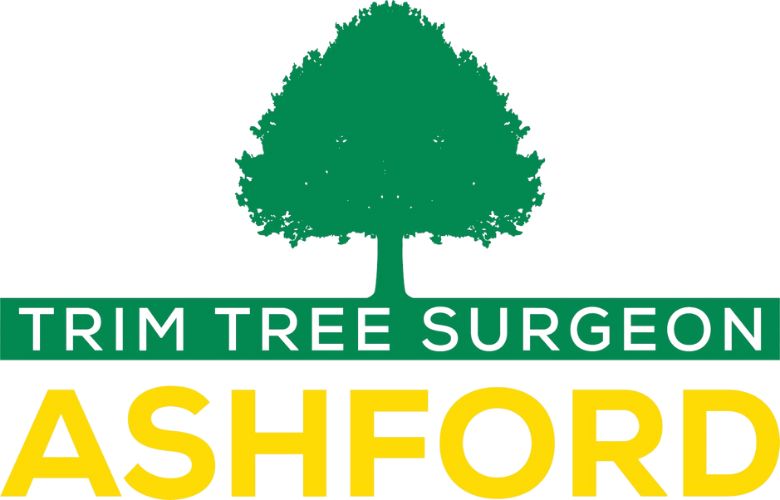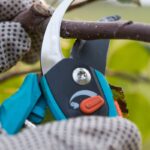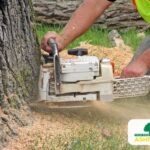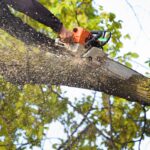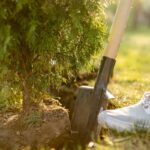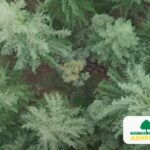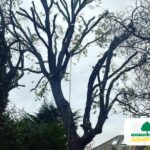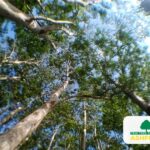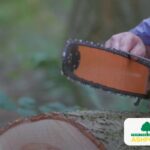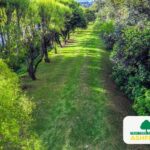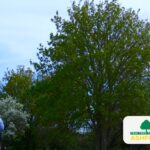Are your trees unwell? Don’t worry, you’ve come to the right place! Here, we’ll provide you with all the info you need about common tree diseases in the UK. We’ll look at the symptoms, how to identify them and the treatment options available.
Picture this: a majestic oak wilting away, an ash tree fading, or an apple tree with scabs. It doesn’t have to be a tragedy – understanding these diseases is the first step to saving your trees.
We’ll take you through some of the most common tree diseases in the UK. From Oak Decline to Dutch Elm Disease, no ailment will escape our attention. Learn how to spot the signs and discover treatments that can help your trees.
Put on your gardening gloves and become a Tree Disease Detective. Let’s explore this intricate world and protect our leafy friends from harm!
Oak Decline
You may be wondering about the symptoms and treatment options for Oak Decline in the UK. Oak Decline is a common tree disease that affects oak trees, causing significant damage and decline in their health.
The main symptoms of Oak Decline include wilting leaves, thinning canopy, dieback of branches, and reduced growth. It is important to note that prevention is key when it comes to oak decline management. Regular inspections of the trees for early signs of disease can help detect and treat the problem before it becomes severe.
Proper tree care practices such as maintaining soil moisture, providing adequate nutrients, and pruning infected branches can help prevent oak decline. If your oak trees are already affected, professional tree surgery may be necessary to minimize further damage.
Moving on to Ash Dieback, another common tree disease in the UK…
Ash Dieback
Embrace the sorrowful dance of nature’s decay as Ash Dieback silently infiltrates and withers the vibrant life that once adorned our landscapes. This devastating tree disease, caused by the fungus Hymenoscyphus fraxineus, has been wreaking havoc on ash trees across the UK. Symptoms of the disease include crown dieback, leaf loss, and bark lesions. Unfortunately, there’s no cure for this destructive disease. However, it’s possible to prevent its spread and manage its impact.
Landowners and authorities must implement measures such as quarantine to restrict movement of infected materials, removal and destruction of infected trees, and replanting with resistant species in order to protect our ash tree population from further devastation.
As we bid farewell to the tragedy of Ash Dieback, let us now turn our attention towards Dutch Elm Disease. This notorious tree disease has caused widespread destruction of elm trees throughout the UK.
Dutch Elm Disease
Dutch Elm Disease is a devastating fungal disease that affects elm trees. Symptoms include wilted leaves, yellowed foliage, and brown streaks in the wood. Treatment options include pruning infected branches, injecting fungicides into the tree, and removing dead or dying elms to stop further spread.
To prevent Dutch Elm Disease, good sanitation is important. This includes disposing of infected wood correctly and avoiding unnecessary pruning in the summer when beetles are most active.
Symptoms of Dutch Elm Disease
Elm trees affected by Dutch Elm Disease display wilting leaves and discoloured bark. The initial symptom of the disease is often yellowing or wilting of one or more branches, which gradually spreads throughout the entire tree canopy. Infected leaves may turn brown and stay attached to the tree instead of falling off in autumn.
As the disease progresses, dark streaks can be seen on the trunk and branches, which is caused by the blockage of water-conducting tissues, leading to branch dieback and eventual death of the tree if left untreated.
Early detection is essential for successful prevention and treatment of Dutch Elm Disease. Being aware of these symptoms can help identify infected trees quickly, allowing for timely intervention to save them from further damage.
Moving onto treatment options for Dutch Elm Disease…
Treatment options for Dutch Elm Disease
One way to combat Dutch Elm Disease is through the use of fungicides, which act as a shield against the destructive pathogen. Fungicides are chemicals specifically designed to target and eliminate fungal infections.
To effectively manage this disease, there are several treatment options available:
Injection: Fungicides can be injected directly into the tree’s trunk or branches, allowing them to circulate throughout the vascular system. This method ensures that the whole tree is protected from the disease.
Soil drenching: Another option is to apply fungicides directly to the soil around the infected tree. The roots absorb these chemicals, providing systemic protection against Dutch Elm Disease.
Foliar spraying: In some cases, it may be necessary to spray fungicides onto the leaves and branches of susceptible trees. This helps prevent further infection by creating a protective barrier.
By using these disease management techniques and incorporating proper prevention strategies for Dutch Elm Disease, you can safeguard your trees against this devastating pathogen without compromising their health and longevity.
Prevention strategies for Dutch Elm Disease
To effectively protect your trees from the devastating effects of Dutch Elm Disease, it’s essential to implement preventative strategies.
Identifying and removing infected trees quickly can help stop the spread of the disease to healthy trees nearby.
Moreover, planting resistant tree species, such as the American Elm (Ulmus americana) and the Princeton Elm (Ulmus ‘Princeton’), can greatly reduce the risk of infection.
By incorporating these prevention strategies, you can ensure that your trees are well protected against this destructive pathogen.
Apple Scab
Apple Scab is a common fungal disease that affects apple trees. It can be treated using fungicides designed to target it, but instructions must be followed carefully. To prevent Apple Scab, strategies to consider include planting resistant apple tree varieties, practicing good sanitation by removing fallen leaves and infected plant material, and providing adequate air circulation around the tree.
Symptoms of Apple Scab
Feeling frustrated with your apple tree’s condition? Let’s discuss the symptoms of Apple Scab and how it affects your beloved fruit.
Apple Scab is a fungal disease common in the UK. Look for small, dark spots on the leaves, which may enlarge into lesions. These lesions can also appear on the fruit, causing it to become misshapen and discoloured.
As the disease progresses, affected leaves may yellow and drop prematurely, reducing photosynthesis and weakening the tree. To prevent apple scab, maintain good tree hygiene by removing fallen leaves and infected fruits promptly.
In the next section, we’ll discuss treatment options without delay.
Treatment options for Apple Scab
There are a plethora of effective treatment methods available for tackling Apple Scab, the pesky fungal disease that can cause havoc to your beloved apple trees. Natural remedies can be quite effective. Pruning infected branches and removing fallen leaves from around the tree can help reduce the spread of spores. Applying a fungicide specifically designed for apple scab can also help control the disease. Remember, fungicides work best as preventative measures rather than curative treatments. Therefore, regular application is key.
Incorporating these treatments into your routine can help you effectively manage Apple Scab and protect your apple trees from further damage.
Now, let’s discuss prevention strategies for Apple Scab…
Prevention strategies for Apple Scab
To effectively prevent Apple Scab, you should regularly apply fungicides and incorporate pruning and leaf removal into your routine. Integrated pest management (IPM) techniques can also be used to reduce the risk of infection. Planting resistant apple varieties, which have been bred to withstand Apple Scab, is a valuable tool. Air circulation should be maintained around trees with proper spacing and thinning. It is important to take preventive measures before symptoms appear, as Apple Scab is hard to eradicate once it takes hold.
Now let’s move on to discussing phytophthora root rot and its management options.
Phytophthora Root Rot
Phytophthora Root Rot is a serious tree disease that can cause significant damage to plants. Symptoms include wilting and discoloration of leaves, as well as a decline in overall plant health.
Treatment includes improving drainage, removing infected plant material, and applying fungicides.
To help prevent the spread of this disease, it’s important to practice good sanitation, avoid overwatering, and select resistant plant varieties.
Symptoms of Phytophthora Root Rot
If you spot wilting, yellowing leaves and a decline in overall tree health, you may be dealing with the symptoms of Phytophthora Root Rot. This common tree disease is caused by a water mould called Phytophthora, which attacks the roots of various tree species.
As the infection progresses, the roots become decayed and unable to absorb water and nutrients effectively. This lack of nutrition leads to leaf discoloration and wilting. In severe cases, the whole tree may die.
To prevent Phytophthora Root Rot, it’s important to avoid overwatering and ensure good drainage around the tree’s root zone. Treatment options include improving soil drainage, removing infected roots, and applying fungicides.
It’s essential to address Phytophthora Root Rot promptly to save your tree from further damage.
Treatment options for Phytophthora Root Rot
When dealing with Phytophthora Root Rot, you’ll want to consider various treatment methods to save your tree from further damage. An effective treatment is the use of fungicides. These chemicals can help suppress the growth and spread of the disease-causing pathogens in the soil. It’s important to choose a fungicide that targets phytophthora species specifically and follow the instructions carefully for application rates and timing.
Cultural practices can also help manage oak decline caused by phytophthora root rot. These include pruning infected branches, improving drainage around the tree, and avoiding overwatering. These practices can reduce stress on the tree and create an environment less favorable for pathogen growth.
Incorporating resistant oak species into your landscape is an effective strategy for preventing damage from phytophthora root rot. Planting trees that are naturally less susceptible to this disease can minimize its impact.
Prevention strategies for phytophthora root rot should also be considered.
Prevention strategies for Phytophthora Root Rot
To prevent Phytophthora Root Rot in your gardening practices, integrated pest management is key. Here are some effective prevention strategies that can help protect your trees:
Proper drainage: Ensure your garden has good drainage to prevent waterlogged soil, as this creates a favorable environment for the disease.
Avoid overwatering: Water your trees appropriately and avoid excessive irrigation, as waterlogged roots are more susceptible to infection.
Crop rotation: If you’ve had a previous outbreak of Phytophthora Root Rot, rotate susceptible tree species with resistant ones to break the disease cycle.
It’s also important to be aware of fungicide resistance. Monitor your trees for signs of infection and consult a professional arborist or horticulturist for appropriate fungicide treatments if needed.
Let’s now discuss the next topic – bleeding canker.
Bleeding Canker
Bleeding Canker is a serious disease that affects various types of trees. Key symptoms include dark, oozing sap on the trunk or branches.
To treat this disease, promptly prune and remove infected wood and apply suitable fungicides.
To prevent Bleeding Canker, maintain tree health by regularly watering, fertilising, and pruning, and avoid causing damage to the tree bark.
Symptoms of Bleeding Canker
Imagine strolling through a verdant forest and suddenly noticing dark, seeping patches on the bark of trees around you. These are the telltale signs of bleeding canker, a prevalent tree disease in the UK.
Bleeding canker is triggered by multiple factors such as fungal infections, bacteria, or environmental stressors like drought or frost damage. It mainly affects hardwood trees like oak, horse chestnut, and beech.
Symptoms of bleeding canker include raised lesions that secrete a sticky fluid, dark stains on the bark, and dieback of branches. Early detection is essential for successful management of this disease.
Pruning infected branches and improving tree health through proper watering and fertilization can help check its spread. Moving on to the next section about treatment options for bleeding canker, knowing these symptoms will assist in selecting the suitable course of action to save your trees without delay.
Treatment options for Bleeding Canker
As you explore potential ways to treat bleeding canker, consider different methods that may effectively combat this tree disease.
There are both cultural and chemical approaches that can be used for treatment. Pruning infected branches is a popular method, and it’s important to make sure to sterilise pruning tools between cuts to prevent further spread of the disease.
Applying a fungicide directly onto the affected areas of the bark may also help to suppress fungal growth and alleviate symptoms. In cases where the infection has spread extensively throughout the tree, it may be necessary to remove the entire tree to prevent further contamination.
It should be noted that treatment may not completely eradicate the disease, but it can help manage its symptoms and slow down its progression. Prevention is also key in managing bleeding canker, and techniques such as promoting good tree health through proper irrigation and fertilisation can help.
Prevention strategies for Bleeding Canker
To prevent bleeding canker, you should focus on maintaining the health of your trees through proper irrigation and fertilization techniques. This will help to strengthen the tree’s immune system and make it less susceptible to infection.
Inspect your trees regularly for any signs of cankers or wounds and act swiftly if any are found; prune affected branches immediately and disinfect pruning tools afterwards.
Additionally, practice good sanitation by removing fallen leaves and debris from around the tree base.
Finally, it’s recommended to choose resistant tree species when planting new trees to minimize the chances of developing bleeding canker.
Following these prevention strategies can help you manage the disease and protect your trees.
Frequently Asked Questions
How can I prevent oak decline in my trees?
To prevent oak decline in your trees, it’s essential to implement effective oak tree health management practices. Regularly inspect your trees for signs of decline, such as thinning canopy and dieback.
Ensure proper nutrition by providing adequate water and nutrients. Prune dead or diseased branches promptly to prevent the spread of infections. Avoid damaging the root system during construction activities near the trees.
Consulting with a certified arborist can provide further guidance on preventing tree decline and maintaining oak tree health.
Are there any natural remedies that can help treat ash dieback?
To effectively address ash dieback, it’s worth considering the potential benefits of natural remedies. Herbal treatments have been explored for their effectiveness, though their efficacy may vary. Some studies suggest that plant extracts and biocontrol agents could offer protection.
Before implementing any natural remedies, it’s important to consult with experts or arborists for the best course of action.
Can Dutch elm disease affect other types of trees besides elms?
Dutch Elm Disease is a fungal infection that primarily affects elm trees, but it can also affect other species such as Zelkova and Planera trees. To control the disease, fungicides can be employed, but their effectiveness can vary depending on the stage of infection and tree health.
Dutch Elm Disease has a significant effect on the overall ecosystem. It causes a decline in elm populations and impacts biodiversity. It is essential to implement management strategies to prevent further spread of this devastating disease.
What are some common signs of apple scab and how can I identify it?
Step up and learn about apple scab! This fungal disease can cause major problems for apple trees. Let’s explore the causes and prevention of apple scab, as well as how to identify and treat it.
The fungus Venturia inaequalis is the main cause of apple scab. It thrives in moist conditions. Look out for dark, scaly lesions on leaves, fruits and twigs to identify it.
Pruning and ensuring good air circulation can help to prevent apple scab. Treating the disease involves using fungicides designed specifically for apple scab.
Knowledge is key to keeping your apple trees healthy and thriving!
Is there a way to prevent phytophthora root rot from spreading to other plants in my garden?
To stop the spread of phytophthora root rot to other plants in your garden, it’s essential to act quickly. Dispose of infected plants and their nearby soil correctly.
Sanitize any tools and equipment used in the affected area. Don’t overwater, as this fungus thrives in humid conditions. Put in proper drainage systems and use soil with good draining capabilities.
Applying fungicides with active ingredients such as metalaxyl or mefenoxam can also be an effective treatment for phytophthora root rot.
Thank you for reading our post, please reach out to us if you enjoyed the article or if you want to explore some of our service please see below:
